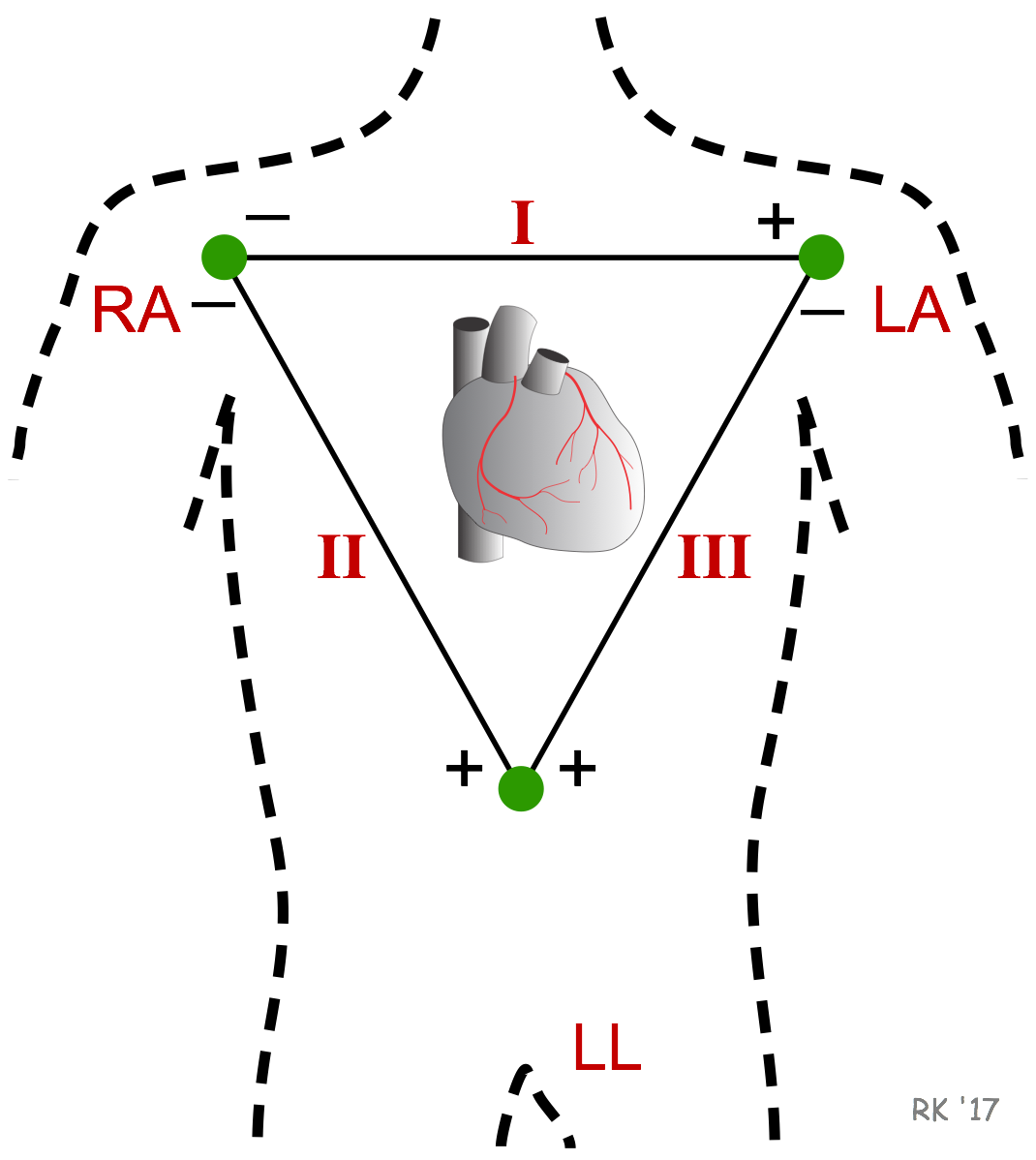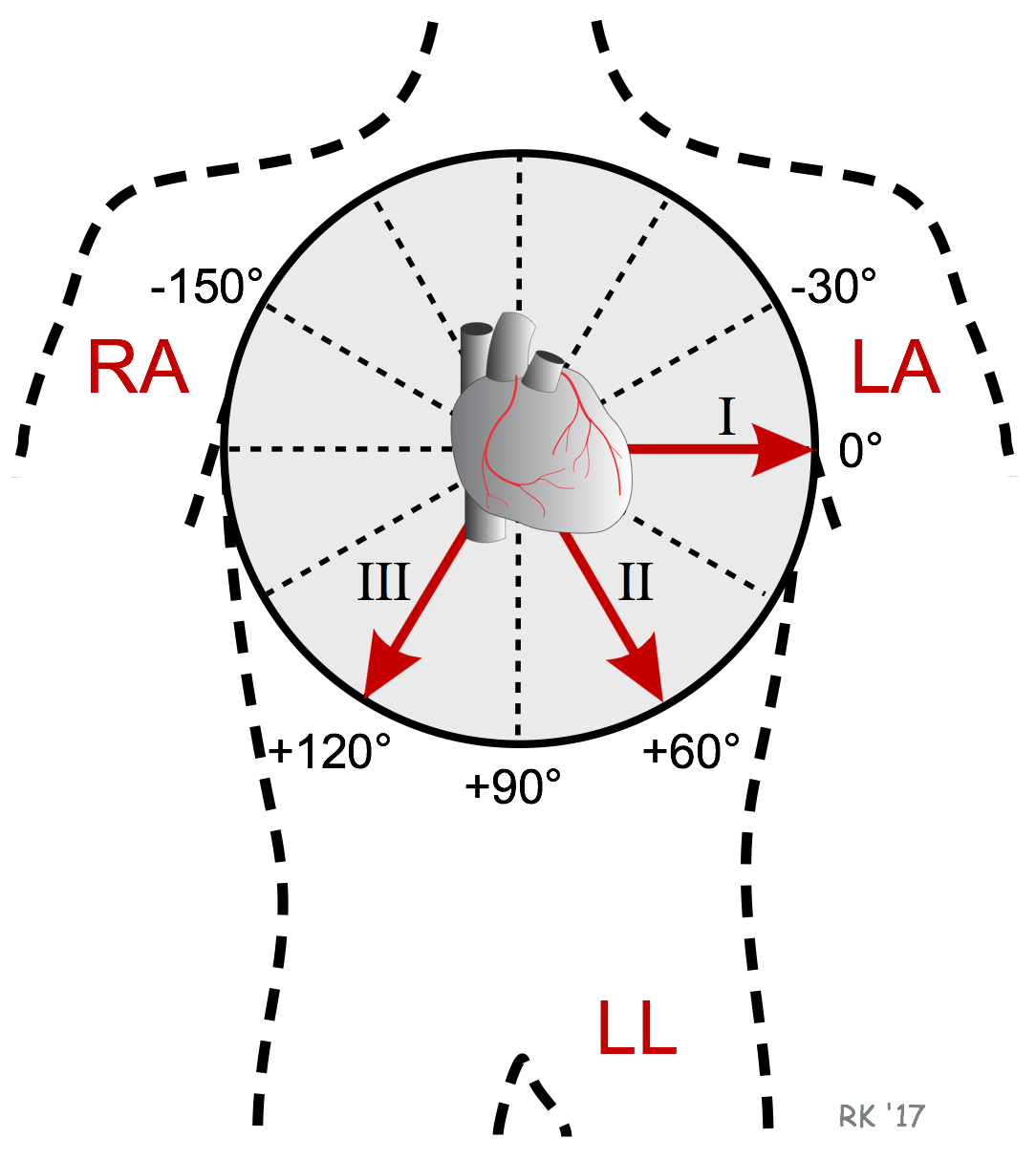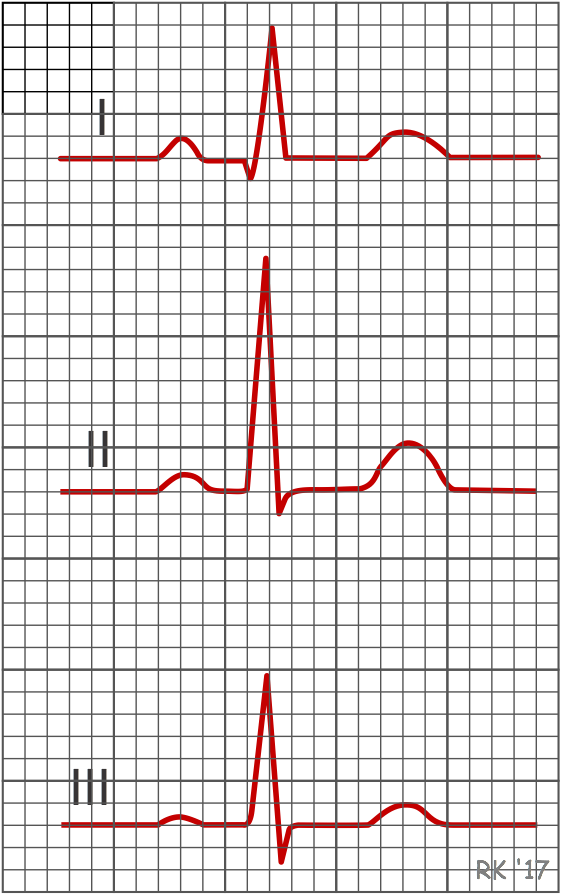Electrocardiogram Standard Limb Leads (Bipolar)
 Bipolar recordings use standard limb lead configurations depicted in the figure. By convention, lead I has the positive electrode on the left arm, and the negative electrode on the right arm, and therefore measures the potential difference between the two arms. In this and the other two limb leads, an electrode on the right leg serves as a reference electrode for recording. In the lead II configuration, the positive electrode is on the left leg and the negative electrode is on the right arm. Lead III has a positive electrode on the left leg and a negative electrode on the left arm. These three bipolar leads roughly form an equilateral triangle (with the heart at the center) that is called Einthoven's triangle in honor of Willem Einthoven, who developed the electrocardiogram in the early 1900s. Whether the limb leads are attached to the end of the limb (wrists and ankles) or at the origin of the limb (shoulder or upper thigh) makes little difference in the recording because the limbs act like a long wire conductor originating from a point on the trunk of the body.
Bipolar recordings use standard limb lead configurations depicted in the figure. By convention, lead I has the positive electrode on the left arm, and the negative electrode on the right arm, and therefore measures the potential difference between the two arms. In this and the other two limb leads, an electrode on the right leg serves as a reference electrode for recording. In the lead II configuration, the positive electrode is on the left leg and the negative electrode is on the right arm. Lead III has a positive electrode on the left leg and a negative electrode on the left arm. These three bipolar leads roughly form an equilateral triangle (with the heart at the center) that is called Einthoven's triangle in honor of Willem Einthoven, who developed the electrocardiogram in the early 1900s. Whether the limb leads are attached to the end of the limb (wrists and ankles) or at the origin of the limb (shoulder or upper thigh) makes little difference in the recording because the limbs act like a long wire conductor originating from a point on the trunk of the body.
Based upon universally accepted ECG rules, a wave of depolarization heading toward the left arm gives a positive deflection in lead I because the positive electrode is on the left arm. Maximal positive ECG deflection occurs in lead I when a wave of depolarization travels parallel to the axis from the right to left arm. If a wave of depolarization heads away from the left arm, the deflection is negative. Furthermore, by these rules, a wave of repolarization moving away from the left arm is recorded as a positive deflection. Similar statements can be made for leads II and III, in which the positive electrode is located on the left leg. For example, a wave of depolarization traveling toward the left leg produces a positive deflection in both leads II and III because the positive electrode for both leads is on the left leg. A maximal positive deflection is recorded in lead II when the depolarization wave travels parallel to the axis between the right arm and left leg. Similarly, a maximal positive deflection is obtained in lead III when the depolarization wave travels parallel to the axis between the left arm and left leg.
 If the three limbs of Einthoven's triangle (assumed to be equilateral) are broken apart, collapsed, and superimposed over the heart, then the positive electrode for lead I is defined as being at zero degrees relative to the heart along the horizontal axis between LL and RA (see figure). Similarly, the positive electrode for lead II (RA-LL axis) will be +60° relative to the heart, and the positive electrode for lead III (LA-LL axis) will be +120° relative to the heart as shown to the right. This construction of the electrical axis is called the axial reference system. With this system, a wave of depolarization traveling at +60° produces the greatest positive deflection in lead II. A wave of depolarization oriented +90° relative to the heart produces equally positive deflections in both lead II and III. In this latter example, lead I shows no net deflection because the wave of depolarization is heading perpendicular to the 0° (lead I) axis (see ECG rules).
If the three limbs of Einthoven's triangle (assumed to be equilateral) are broken apart, collapsed, and superimposed over the heart, then the positive electrode for lead I is defined as being at zero degrees relative to the heart along the horizontal axis between LL and RA (see figure). Similarly, the positive electrode for lead II (RA-LL axis) will be +60° relative to the heart, and the positive electrode for lead III (LA-LL axis) will be +120° relative to the heart as shown to the right. This construction of the electrical axis is called the axial reference system. With this system, a wave of depolarization traveling at +60° produces the greatest positive deflection in lead II. A wave of depolarization oriented +90° relative to the heart produces equally positive deflections in both lead II and III. In this latter example, lead I shows no net deflection because the wave of depolarization is heading perpendicular to the 0° (lead I) axis (see ECG rules).

For a heart with a normal ECG and a mean electrical axis of +60°, the standard limb leads will appear as shown by the ECG tracings. See also: Augmented Limb Leads (Unipolar) AND Chest Leads (Unipolar)
Revised 11/02/2023

 Cardiovascular Physiology Concepts, 3rd edition textbook, Published by Wolters Kluwer (2021)
Cardiovascular Physiology Concepts, 3rd edition textbook, Published by Wolters Kluwer (2021) Normal and Abnormal Blood Pressure, published by Richard E. Klabunde (2013)
Normal and Abnormal Blood Pressure, published by Richard E. Klabunde (2013)